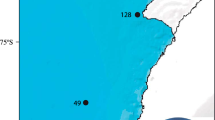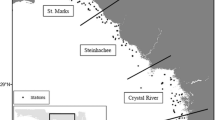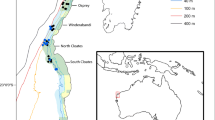Abstract
Marine invasive species can profoundly alter ecosystem processes by displacing native species and changing community structures. The invasive tunicate Didemnum vexillum was first found on the northern edge of Georges Bank in 1998. It can form encrusting colonies on gravel substrates that are also a preferred habitat for a number of other invertebrates. In this study we used data collected via HabCam, a vessel-towed underwater imaging system, to investigate the distribution of D. vexillum and its relationship to other epibenthic macroinvertebrates in a portion of Georges Bank that includes fishing grounds and an area protected from bottom-fishing. This novel technology provides imaging of epibenthic species distributions in areas of the benthic environment that were previously unobservable. We found that D. vexillum density is negatively correlated with the Atlantic sea scallop (Placopecten magellanicus), barnacles (genus Balanus), the tube anemone (genus Cerianthus), the green sea urchin (Strongylocentrotus droebachiensis), the globular sponge of the genus Polymastia, and Bryozoa. However D. vexillum is positively correlated with Cancer spp. Crabs, the tube forming polychaete, Filograna implexa, and Asterias spp. sea stars. The hypothesis that D. vexillum restructures the invertebrate community is supported by principal components analysis, revealing it as a primary driver of variation in the community when present. Additionally, there is an effect of the closed area as compared to fishing grounds on the structure of the invertebrate community and the abundance of certain species as consistent with previous studies, bottom-fishing affects invertebrate community structure. Principal components analysis revealed that bottom-fishing also appears to weaken clustering among species in the invertebrate community as compared to the community structure in the closed area. Biodiversity in high gravel sites of the epibenthic environment, as measured by the Shannon diversity index, also declined with increasing D. vexillum percent cover, while the open and closed areas were not significantly different in their level of biodiversity. D. vexillum appears to be the key driver of biodiversity decline in the epibenthos when present, rather than other processes such as direct disturbance and extraction from dredging. This research evaluates ecological responses to the presence of an invasive tunicate and suggests that this invasive species is a major force in shaping the ecological interactions in invaded areas.







Similar content being viewed by others
References
Asch RG, Collie JS (2008) Changes in a benthic megafaunal community due to disturbance from bottom fishing and the establishment of a fishery closure. Fish Bull 106:438–456
Auster PJ, Malatesta RJ, Langton RW et al (1996) The impacts of mobile fishing gear on seafloor habitats in the gulf of Maine (Northwest Atlantic): implications for conservation of fish populations. Rev Fish Sci 4:185–202. doi:10.1080/10641269609388584
Bauer JT (2012) Invasive species: “back-seat drivers” of ecosystem change? Biol Invasions 14:1295–1304. doi:10.1007/s10530-011-0165-x
Berman M, Andersen AN, Ibanez T (2013) Invasive ants as back-seat drivers of native ant diversity decline in New Caledonia. Biol Invasions 15:2311–2331. doi:10.1007/s10530-013-0455-6
Bradshaw C, Veale LO, Brand AR (2002) The role of scallop-dredge disturbance in long-term changes in Irish Sea benthic communities: a re-analysis of an historical dataset. J Sea Res 47:161–184. doi:10.1016/S1385-1101(02)00096-5
Bullard SG, Lambert G, Carman MR et al (2007) The colonial ascidian Didemnum sp. A: current distribution, basic biology and potential threat to marine communities of the northeast and west coasts of North America. J Exp Mar Biol Ecol 342:99–108. doi:10.1016/j.jembe.2006.10.020
Butman B, Beardsley R (1987) The Georges Bank, 1st edn. The MIT Press, Cambridge
Carman MR, Allen HM, Tyrrell MC (2009) Limited value of the common periwinkle snail Littorina littorea as a biological control for the invasive tunicate Didemnum vexillum. Aquat Invasions 4:291–294
Carman M, Grunden D, Ewart D (2014) Coldwater reattachment of colonial tunicate Didemnum vexillum fragments to natural (eelgrass) and artificial (plastic) substrates in New England. Aquat Invasions 9:105–110. doi:10.3391/ai.2014.9.1.09
Chabrerie O, Verheyen K, Saguez R, Decocq G (2008) Disentangling relationships between habitat conditions, disturbance history, plant diversity, and American black cherry (Prunus serotina Ehrh.) invasion in a European temperate forest. Divers Distrib 14:204–212. doi:10.1111/j.1472-4642.2007.00453.x
Cohen CS, McCann LD, Davis T et al (2011) Discovery and significance of the colonial tunicate Didemnum vexillum in Alaska. Aquat Invasions 6:263–271. doi:10.3391/ai.2011.6.3.03
Collie JS, Escanero GA, Valentine PC (1998) Effects of bottom fishing on the benthic mega-fauna of Georges Bank. Oceanogr Lit Rev 2:386
Collie JS, Hermsen JM, Valentine PC (2009) Recolonization of gravel habitats on Georges Bank (northwest Atlantic). Deep Sea Res Part II Top Stud Oceanogr 56:1847–1855. doi:10.1016/j.dsr2.2009.05.025
Daley BA, Scavia D (2008) An integrated assessment of the continued spread and potential impacts of the colonial ascidian, Didemnum sp. A, in U.S. waters. http://coastalscience.noaa.gov/publications/nccos78.pdf. Accessed 13 May 2015
Didham RK, Tylianakis JM, Hutchison MA et al (2005) Are invasive species the drivers of ecological change? Trends Ecol Evol 20:470–474. doi:10.1016/j.tree.2005.07.006
Didham RK, Tylianakis JM, Gemmell NJ et al (2007) Interactive effects of habitat modification and species invasion on native species decline. Trends Ecol Evol 22:489–496. doi:10.1016/j.tree.2007.07.001
Dijkstra J, Harris L (2007) Predicting the success of invasive species in the great bay estuarine reserve. PREP Publications University of New Hampshire, Durham
Dijkstra J, Nolan R (2011) Potential of the invasive colonial ascidian, Didemnum vexillum, to limit escape response of the sea scallop, Placopecten magellanicus. Aquat Invasions 6:451–456. doi:10.3391/ai.2011.6.4.10
Epelbaum A, Pearce CM, Barker DJ et al (2009) Susceptibility of non-indigenous ascidian species in British Columbia (Canada) to invertebrate predation. Mar Biol 156:1311–1320. doi:10.1007/s00227-009-1172-7
Fenesi A, Geréd J, Meiners SJ et al (2015) Does disturbance enhance the competitive effect of the invasive Solidago canadensis on the performance of two native grasses? Biol Invasions 17:3303–3315. doi:10.1007/s10530-015-0954-8
Fogarty MJ, Murawski SA (1998) Large-scale disturbance and the structure of marine systems: fishery impacts on georges bank. Ecol Appl 8:S6–S22. doi:10.1890/1051-0761(1998)8[S6:LDATSO]2.0.CO;2
Forrest BM, Fletcher LM, Atalah J et al (2013) Predation limits spread of Didemnum vexillum into natural habitats from refuges on anthropogenic structures. PLoS ONE 8:e82229. doi:10.1371/journal.pone.0082229
Freese L, Auster PJ, Heifetz J, Wing BL (1999) Effects of trawling on seafloor habitat and associated invertebrate taxa in the Gulf of Alaska. Mar Ecol Prog Ser 182:119–126. doi:10.3354/meps182119
Gaymer CF, Dutil C, Himmelman JH (2004) Prey selection and predatory impact of four major sea stars on a soft bottom subtidal community. J Exp Mar Biol Ecol 313:353–374. doi:10.1016/j.jembe.2004.08.022
Gittenberger A (2007) Recent population expansions of non-native ascidians in The Netherlands. J Exp Mar Biol Ecol 342:122–126. doi:10.1016/j.jembe.2006.10.022
Grarock K, Tidemann CR, Wood JT, Lindenmayer DB (2014) Are invasive species drivers of native species decline or passengers of habitat modification? A case study of the impact of the common myna (Acridotheres tristis) on Australian bird species. Austral Ecol 39:106–114. doi:10.1111/aec.12049
Heck KL, Hambrook JA (1991) Intraspecific interactions and risk of predation for Dyspanopeus sayi (Decapoda: Xanthidae) living on polychaete (Filograna implexa, Serpulidae) colonies*. Mar Ecol 12:243–250. doi:10.1111/j.1439-0485.1991.tb00256.x
Herborg L-M, O’Hara P, Therriault TW (2009) Forecasting the potential distribution of the invasive tunicate Didemnum vexillum. J Appl Ecol 46:64–72. doi:10.1111/j.1365-2664.2008.01568.x
Hermoso V, Clavero M, Blanco-Garrido F, Prenda J (2011) Invasive species and habitat degradation in Iberian streams: an analysis of their role in freshwater fish diversity loss. Ecol Appl 21:175–188. doi:10.1890/09-2011.1
Hinz H, Prieto V, Kaiser MJ (2009) Trawl disturbance on benthic communities: chronic effects and experimental predictions. Ecol Appl 19:761–773. doi:10.1890/08-0351.1
Howland J, Gallager S, Singh H et al (2006) Development of a towed survey system for deployment by the fishing industry. In: OCEANS 2006. IEEE, pp 1–5
Jenkins SR, Mullen C, Brand AR (2004) Predator and scavenger aggregation to discarded by-catch from dredge fisheries: importance of damage level. J Sea Res 51:69–76. doi:10.1016/j.seares.2003.05.002
Jennings S, Kaiser MJ (1998) The effects of fishing on marine ecosystems. In: Blaxter JHS, Southward AJ (eds) Advances in marine biology. Academic Press, Cambridge, pp 201–352
Kaplan KA, Hart DR, Hopkins K et al (2017) Evaluating the interaction of the invasive tunicate Didemnum vexillum with the Atlantic sea scallop Placopecten magellanicus on open and closed fishing grounds of Georges Bank. ICES J Mar Sci. doi:10.1093/icesjms/fsx076
Kott P (2002) A complex didemnid ascidian from Whangamata, New Zealand. J Mar Biol Assoc U K 82:625–628. doi:10.1017/S0025315402005970
Lengyel NL, Collie JS, Valentine PC (2009) The invasive colonial ascidian Didemnum vexillum on Georges Bank—ecological effects and genetic identification. Aquat Invasions 4(1):143–152. doi:10.3391/ai.2009.4.1.15
Light T, Marchetti MP (2007) Distinguishing between invasions and habitat changes as drivers of diversity loss among California’s freshwater fishes. Conserv Biol 21:434–446. doi:10.1111/j.1523-1739.2006.00643.x
Lozon JD, MacIsaac HJ (1997) Biological invasions: are they dependent on disturbance? Environ Rev 5:131–144. doi:10.1139/a97-007
MacDougall AS, Turkington R (2005) Are invasive species the drivers or passengers of change in degraded ecosystems? Ecology 86:42–55. doi:10.1890/04-0669
Marvier M, Kareiva P, Neubert MG (2004) Habitat destruction, fragmentation, and disturbance promote invasion by habitat generalists in a multispecies metapopulation. Risk Anal 24:869–878. doi:10.1111/j.0272-4332.2004.00485.x
McCann LD, Holzer KK, Davidson IC et al (2013) Promoting invasive species control and eradication in the sea: options for managing the tunicate invader Didemnum vexillum in Sitka, Alaska. Mar Pollut Bull 77:165–171. doi:10.1016/j.marpolbul.2013.10.011
Mercer JM, Whitlatch RB, Osman RW (2009) Potential effects of the invasive colonial ascidian (Didemnum vexillum Kott, 2002) on pebble-cobble bottom habitats in Long Island Sound, USA. Aquat Invasions 4:133–142. doi:10.3391/ai.2009.4.1.14
Molnar JL, Gamboa RL, Revenga C, Spalding MD (2008) Assessing the global threat of invasive species to marine biodiversity. Front Ecol Environ 6:485–492. doi:10.1890/070064
Moore AM, Vercaemer B, DiBacco C et al (2014) Invading Nova Scotia: first records of Didemnum vexillum Kott, 2002 and four more non-indigenous invertebrates in 2012 and 2013. Bioinvasions Rec 3:225–234. doi:10.3391/bir.2014.3.4.03
Morris JA, Carman MR (2012) Fragment reattachment, reproductive status, and health indicators of the invasive colonial tunicate Didemnum vexillum with implications for dispersal. Biol Invasions 14:2133–2140. doi:10.1007/s10530-012-0219-8
Morris JA, Carman MR, Hoagland KE et al (2009) Impact of the invasive colonial tunicate Didemnum vexillum on the recruitment of the bay scallop (Argopecten irradians irradians) and implications for recruitment of the sea scallop (Placopecten magellanicus) on Georges Bank. Aquat Invasions 4:207–211. doi:10.3391/ai.2009.4.1.21
Osman RW, Whitlatch RB (2007) Variation in the ability of Didemnum sp. to invade established communities. J Exp Mar Biol Ecol 342:40–53. doi:10.1016/j.jembe.2006.10.013
Potts JM, Elith J (2006) Comparing species abundance models. Ecol Model 199:153–163. doi:10.1016/j.ecolmodel.2006.05.025
Ramsay K, Kaiser MJ, Hughes RN (1998) Responses of benthic scavengers to fishing disturbance by towed gears in different habitats. J Exp Mar Biol Ecol 224:73–89. doi:10.1016/S0022-0981(97)00170-6
Rebach S (1996) Role of prey odor in food recognition by rock crabs, Cancer irroratus say. J Chem Ecol 22:2197–2207. doi:10.1007/BF02029540
Shank BV, Hart DR, Friedland KD (2012) Post-settlement predation by sea stars and crabs on the sea scallop in the Mid-Atlantic Bight. Mar Ecol Prog Ser 468:161–177. doi:10.3354/meps09974
South PM, Thomsen MS (2016) The ecological role of invading Undaria pinnatifida: an experimental test of the driver–passenger models. Mar Biol 163:175. doi:10.1007/s00227-016-2948-1
Stefaniak L, Zhang H, Gittenberger A et al (2012) Determining the native region of the putatively invasive ascidian Didemnum vexillum Kott, 2002. J Exp Mar Biol Ecol 422–423:64–71. doi:10.1016/j.jembe.2012.04.012
Taylor R, Vine N, York A et al (2008) Evolution of a benthic imaging system from a towed camera to an automated habitat characterization system. In: OCEANS 2008. IEEE, pp 1–7
Tillin HM, Hiddink JG, Jennings S, Kaiser MJ (2006) Chronic bottom trawling alters the functional composition of benthic invertebrate communities on a sea-basin scale. Mar Ecol Prog Ser 318:31–45. doi:10.3354/meps318031
Twichell DC, Butman B, Lewis RS (1987) Shallow structure, surficial geology and the processes currently shaping the bank. In: Backus RH (ed) Georges Bank. Massachusetts Institute of Technology Press, Cambridge, pp 31–37
Valentine PC, Carman MR, Blackwood DS, Heffron EJ (2007a) Ecological observations on the colonial ascidian Didemnum sp. in a New England tide pool habitat. J Exp Mar Biol Ecol 342:109–121. doi:10.1016/j.jembe.2006.10.021
Valentine PC, Collie JS, Reid RN et al (2007b) The occurrence of the colonial ascidian Didemnum sp. on Georges Bank gravel habitat—ecological observations and potential effects on groundfish and scallop fisheries. J Exp Mar Biol Ecol 342:179–181. doi:10.1016/j.jembe.2006.10.038
Valentine PC, Carman MR, Dijkstra J, Blackwood DS (2009) Larval recruitment of the invasive colonial ascidian Didemnum vexillum, seasonal water temperatures in New England coastal and offshore waters, and implications for spread of the species. Aquat Invasions 4:153–168
White SR, Tannas S, Bao T et al (2013) Using structural equation modelling to test the passenger, driver and opportunist concepts in a Poa pratensis invasion. Oikos 122:377–384. doi:10.1111/j.1600-0706.2012.20951.x
York A, Gallager S, Taylor R et al (2008) Using a towed optical habitat mapping system to monitor the invasive tunicate species Didemnum sp. along the northeast continental shelf. In: OCEANS 2008. IEEE, pp 1–9
Acknowledgements
The analysis for this project was conducted as part of dissertation work funded through the National Marine Fisheries Service and Sea Grant (E/MP-23) Population Dynamics Graduate Fellowship: Evaluating Atlantic sea scallop habitat effects from bottom-fishing using the Habitat Mapping Camera System. The data for this project were collected as part of an industry-based survey through the Research Set-Aside program designed to collect information on scallop biomass and habitat (NOAA Award Number: NA12NMF4540040, Scallop Research Set Aside Award Number: 12-SCA-016). A special thanks to B Knuth, D Harvell and L Rudstam and the Sullivan lab group for discussions and their advice on manuscript preparation. We would also like to thank the editor and two anonymous reviewers for Biological Invasions for their detailed reviews and commentary that helped improve this manuscript.
Author information
Authors and Affiliations
Corresponding author
Appendix
Rights and permissions
About this article
Cite this article
Kaplan, K.A., Hart, D.R., Hopkins, K. et al. Invasive tunicate restructures invertebrate community on fishing grounds and a large protected area on Georges Bank. Biol Invasions 20, 87–103 (2018). https://doi.org/10.1007/s10530-017-1517-y
Received:
Accepted:
Published:
Issue Date:
DOI: https://doi.org/10.1007/s10530-017-1517-y





